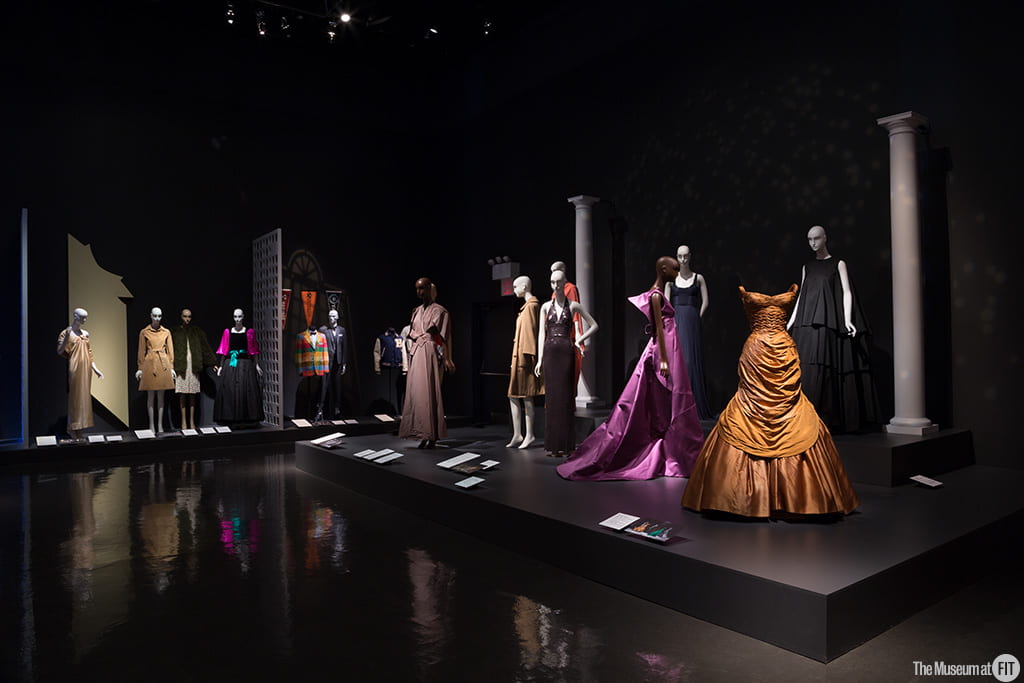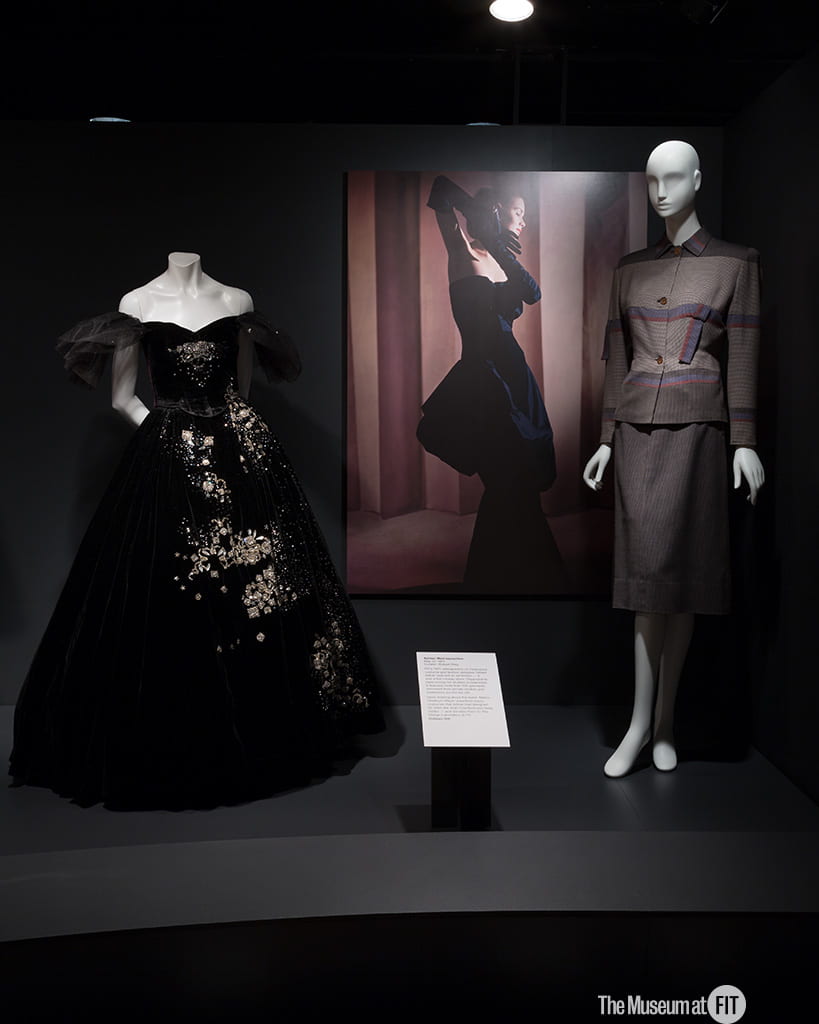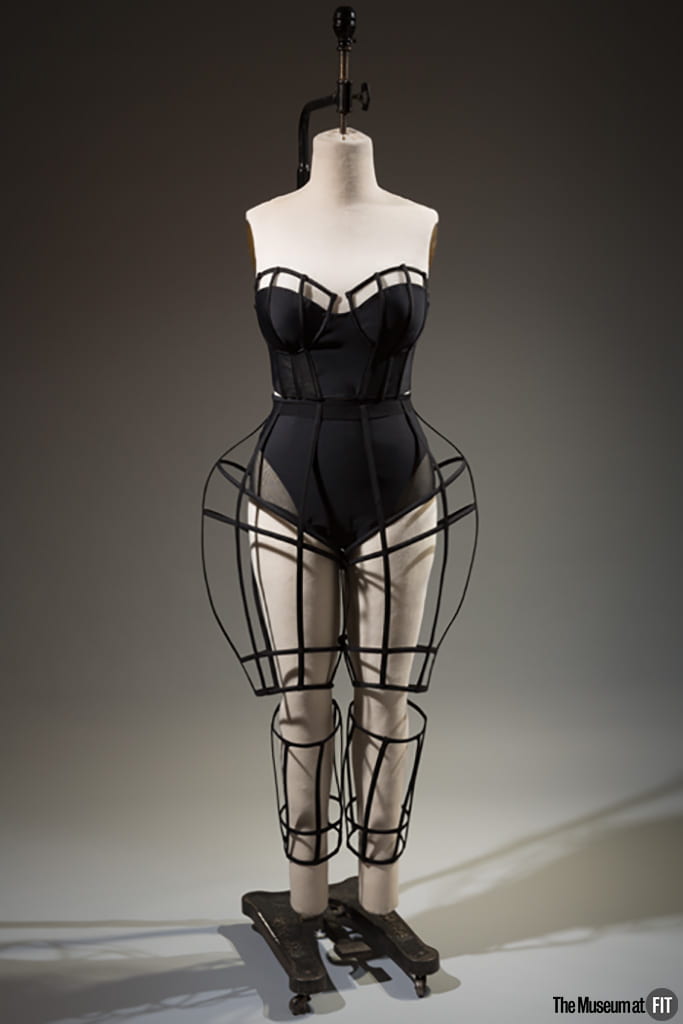
“Exhibitionism” installation view, Museum at FIT, 2019. Photograph: Eileen Costa, courtesy of the Museum at FIT.
By Contributing Writer Sarah Pickman
For those with an interest in fashion history, springtime in New York City heralds the opening of The Metropolitan Museum of Art’s annual summer Costume Institute exhibition. The Costume Institute show (this year’s is “Camp: Notes on Fashion”) and its glittery opening gala in early May inevitably attract a huge amount of press and public attention – so much that they threaten to overshadow other fashion exhibitions. But any museum visitor who wishes to understand more about how these exhibitions developed as a scholarly practice will be rewarded by a trip to the Museum at the Fashion Institute of Technology (MFIT). MFIT – originally called the Design Laboratory and Galleries at FIT – opened in 1969. Since then, it has played host to over two hundred exhibitions, most organized by MFIT’s dedicated team of in-house curators. In celebration of the fiftieth anniversary of the museum’s founding, earlier this year MFIT opened “Exhibitionism: 50 Years of the Museum at FIT.” This show is a reminder of how fashion scholarship has developed over the past few decades, and the potential for even the most eye-catching garments to be pedagogical tools.
“Exhibitionism” highlights thirty-three of MFIT’s prior exhibitions. Presented on mannequins in front of black walls and divided by sleek wooden dividers, garments from these shows are displayed as brief vignettes, two or three from each exhibition clustered together. Accompanying labels summarize the exhibitions in which these clothes were originally shown, the names of the original exhibitions’ curators, and a brief explanation of their curatorial arguments and intentions. Viewers are led from early MFIT exhibitions almost to the present: from 1976’s “Poiret, King of Fashion” – which pulled groundbreaking early twentieth-century designer Paul Poiret out of the obscurity into which he’d fallen – to 2017’s “Expedition: Fashion from the Extreme,” which investigated the influence of exploration and extreme environments on high fashion in an increasingly changing, warming world. Tracing fifty years of curatorial work and thirty-three specific shows in just two rooms is a dizzying feat. Yet the exhibition’s spare, uncluttered design allows viewers to hone in on the garments on display and the accompanying explanatory labels.

Selections from the MFIT’s 1971 “Adrian” exhibition, installation view of “Exhibitionism.” Photograph: Eileen Costa, courtesy of the Museum at FIT.
At first glance, the idea of an exhibition dedicated to the “greatest hits” of a museum’s past might seem like an exercise in self-congratulation. And “Exhibitionism” is, in concept, quite straightforward. But the exhibition, while clearly a tribute to MFIT’s history and its current and previous curators, is also an important marker in the continuing history of fashion scholarship. Half a century old, and embedded within the larger academic institution of the Fashion Institute of Technology, MFIT helped forge the genre of scholarly exhibitions on dress in its current form. In the introductory video for “Exhibitionism,” MFIT Director Valerie Steele explains her conviction that a fashion exhibit can be “more than a display of beautiful clothes,” and this attitude can be seen in the arc of past exhibitions in the show. Visitors to “Exhibitionism” see highlights from early MFIT exhibitions that often showcased the work of single, glamorous fashion designers. For example, its very first presentation, 1971’s Adrian, was a tribute to prominent 1930s and 1940s Hollywood costumer Adrian Gilbert. But the highlighted exhibitions become increasingly more conceptual (exemplified by 1987’s “Fashion and Surrealism” and 2014’s “Faking It: Originals, Copies, and Counterfeits”) and increasingly dedicated to engaging with the social and cultural dimensions of clothing. This is evidenced in the more recent showcased exhibitions such as “A Queer History of Fashion: From the Closet to the Catwalk” (2013), “Black Fashion Designers” (2016), and “The Body: Fashion and Physique” (2017), which explored complex and shifting histories of the “ideal body” in the Western world and the relationship between clothing and politics of the body.
Left: Installation of selections from the 2017 “Body” exhibition, including the Chromat piece pictured to the right. Photograph: Eileen Costa, courtesy of the Museum at FIT. Right: Chromat, ensemble, Spring 2015, USA. Collection of MFIT.
Left: Versace suit from the 1991 “Pop Art” collection. Collection of the Museum at FIT. Right: Installation view of selections of the 2013 exhibition, “A Queer History of Fashion,” with the Versace suit at the center. Photograph: Eileen Costa, courtesy of the Museum at FIT.
Left: Installation of selections from the 2016 exhibition “Black Fashion Designers.” Photograph: Eileen Costa, courtesy of the Museum at FIT. Right: Duro Olowu ensemble, Fall 2012, England, Gift of Duro Olowu, collection of the Museum at FIT.
This visual history of MFIT is a reminder of the potential of fashion exhibitions, and fashion scholarship more broadly, to contribute to important ongoing academic conversations. Historically, fashion exhibitions have often been criticized for being pure entertainment for museum visitors: heavy on spectacle and light on scholarly investigation and provocation. Such a critique has been lobbed from both within the museum world and without, and often rests on the gendering of fashion itself. In the words of historian Lou Taylor, “In the eyes of male museum staff, fashionable dress…[often] evoked notions of vulgar commerciality and valueless, ephemeral, feminine style.” Steele, writing in a 2008 article on fashion exhibitions, noted that several then-recent examples (including shows at high-profile institutions such as the Guggenheim Museum and The Metropolitan Museum of Art) had been criticized for their overt corporate sponsorship as well as for being “merely spectacles designed to pull in admission money rather than exhibitions of interpretive depth.”
At the same time, though, one of the strengths of museum exhibitions is their ability to bring scholarly ideas to a broader audience. And arguably, drawing in museum visitors with visually appealing objects, then using those objects to engage them in connecting past to present, academic debates to real-world consequences, can be an effective strategy. Such engagement is visible quite close to where “Exhibitionism” is on display. In an adjacent gallery at MFIT, the museum is concurrently running the show “Fabric in Fashion,” which discusses histories of silk, wool, cotton, and synthetic fibers. This exhibition seduces viewers with dozens of beautiful historic and contemporary garments made of these raw materials, while the accompanying text reminds them that such clothes are the result of centuries of Western colonization, the Atlantic slave trade, and the environmental destruction wrought by the petroleum industry. It’s a refreshingly relevant way to use dress in a museum setting, and one that demonstrates the potential of an exhibition to engage a broad audience in uncomfortable but necessary conversations.
Granted, as scholars from anthropology to psychology have shown, museum exhibitions in general are subject to multiple levels of viewer interpretation. It’s impossible to completely control how much of the curator’s argument a visitor will absorb, especially if they don’t read any of the labels. And as Steele writes, “As a medium of intellectual communication, certain exhibitions may be less like sustained intellectual arguments than like essays…Some exhibitions may even be like poems or films, evocative and inspiring even when they are not entirely understood.” The challenge for a museum, then, is to continually look for methods of interpretation that will reach as many people as possible, as MFIT has done – through exhibitions as well as free public programming, school visits, web content, and scholarly catalogues. In some ways, museums housed within universities may be uniquely well positioned to do this, as the students who will become the next generation of material culture scholars are trained in close proximity to exhibition spaces and rich collections of objects to study. All of the pieces in “Exhibitionism” are drawn from MFIT’s own large permanent collection, and the accompanying labels indicate that most of them have been used in multiple exhibitions – some in six or seven different shows. And the Fashion Institute of Technology is home to an M.A. program in Fashion and Textile Studies: History, Theory, Museum Practice, whose students have organized some of the hundreds of exhibitions at MFIT. If there is anything “Exhibitionism” lacks it is a more in-depth discussion of how these past exhibitions were planned, designed, and installed, and greater acknowledgement of the individuals – from graduate students and editors to educators and art handlers, as well as curators – who made them possible.
“Exhibitionism,” then, is a straightforward celebration of MFIT’s past that nonetheless reveals the tension between glittery display and scholarly exercise, and gestures to the potential of clothing to engage visitors with social history. In documenting the history of MFIT, it also adds to a valuable and growing body of work on the history of fashion scholarship itself. As Steele told an interviewer about “Exhibitionism,” “[Exhibiting fashion] is important because no field can progress if it doesn’t know where it has been and why.” For the curious, a visit to “Exhibitionism” is sure to answer some of those “where” and “why” questions.
“Exhibitionism: 50 Years of the Museum at FIT” is on view at the Museum at the Fashion Institute of Technology until April 20, 2019. An accompanying catalogue is available from Skira.“Fabric in Fashion” is on view until May 11, 2019.
Sarah Pickman is a Ph.D. student in History of Science and Medicine at Yale University. Her research centers on American and British exploration, anthropology, and natural history museums in the long nineteenth century, with a focus on the material culture of expeditions, particularly in the exploration of the Arctic and Antarctica. She holds a B.A. in Anthropology from the University of Chicago and an M.A. in Decorative Arts, Design History, and Material Culture from the Bard Graduate Center of Bard College.









